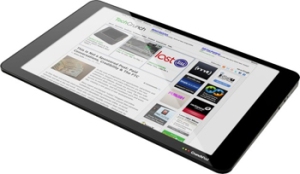Someone should just put a deadbolt on my laptop lid. When I peruse my Twitter feed I see nothing but scary newspaper industry news, which flows like a river of red ink across my pixels. Reading too much of it makes me think a prescription for Prozac might be in my future. I’ve begun to notice even journalism pundits have started to turn on each other by criticizing the need for yet another conference on “Envisioning the Newspaper of Future.”
Truth be told, no one really knows when printing presses will grind to a halt and news delivery boys and girls will be forced to hang up their logoed paper bags for good.
I had to laugh, last week in Portland, Oregon, my former newspaper editor Steve A. Smith was the keynote speaker at “We Make the Media”—“A conference held to develop real-world plans for new media organizations to fill the journalism gaps left by shrinking news staffs at legacy media organizations.” As Smith was speaking about the need to save “professional” journalism, back in the corner of the room were a bunch of self-proclaimed snarky bloggers and citizen journalists who took offense to the notion professional journalism should be saved. Of course they twittered their opinions of Smith’s speech in real time. This, I guess, is the new digital divide, where any journalist older than thirty is viewed with mistrust. Hmmm, where have I heard that before?
It does seem the pace of handwringing is accelerating. The print folk, locked in their silos, are defending their turf as they make their last stand. Online departments are taking the brunt of the next wave of job cuts. If newspapers can’t hold the line on circulation and revenue, it will soon be curtains for the rest of us still drawing a paycheck. Or so I’m told. I hope I can last a bit longer, only because I truly believe, if we can make this digital transition, the future will not be as dismal as I was once led to believe.
Here’s my vision of how I see it playing out in the near future:
- A new breed of touch tablet readers hits the market in 2010-2011. Newspaper publishers at first shun the devices. Then one gutsy newspaper chain embraces them. They form a partnership with the tablet maker to subsidize the cost for the consumer. The more publications a consumer subscribes to, the less they have to pay for the reader. Others soon follow…
- A newspaper’s survival will be based on how many current subscribers can be converted to the digital replica of the newspaper. Replica is the key here. A newspaper’s digital future starts with making the transition simple (familiar) for print consumers to make. It’s the newspaper, only better…
- What will sell the tablet service is all the new things subscribers will be able to do with their wireless digital newspapers. Pictures will come alive with video and audio, graphics become interactive with a tap of a finger, Text can be set to be read aloud. Subscribers should easily be able to customize the paper to fit their needs. Want the sports page as your front page? No problem. Want more stories about your favorite pro baseball team? You bet!
- The value to the tablet subscriber has to be so huge that they be crazy not to plunk down their cash. The same goes for advertisers, whose ads will now have added value. Tap on an ad for a big-screen TV at Best Buy and get more info about the product. Tap a grocery store coupon to print it out.
- Advertisers should be allowed to update their ads in real-time. Think about it. Let’s say you’re a local shoe store looking to move 1000 pairs of shoes. You place the ad in the morning showing the shoes at 20% off. By 2 p.m. you have 500 left and you want to sell them faster, you log into your account and update the ad yourself, dropping the price to 30% off. Don’t you think a whole bunch of those types of ads would draw traffic to a digital newspaper? How about subscriber-only deals? Advertising will be targeted to subscriber’s tastes and talents.
- Everyone talks about how they can’t make any money in online. The simple truth is most newspaper Web sites are not easy to navigate. They can’t display ads as effectively as a print newspaper. If newspapers are going to make this digital transition successful, then making the viewing experience for former print subscribers and advertisers as elegant as possible is paramount.
Finally, a few words about content. Our journalism is what’s most important and will no doubt have to be upgraded. Words and multimedia will need to work better together. The strength in the touch tablet is in its multimedia capabilities. Visuals like photo galleries, graphics, and hi-def video, will add value. Like your current Web site, the front page of the digital newspaper will change as stories are updated throughout the day. The page design will slowly change to integrate new content features.
Once this happens, the true digital media revolution will begin to take place. Yes, the presses will eventually stop, which will only strengthen digital media’s position. Freed of the cost of printing and distribution, more resources will go to content creators. This is when the fun really starts. True innovation will kick in with each new tablet version. New types of devices will drive even more innovation and hopefully a super-renaissance of journalism. My vision may be utopia to some, but the internal optimist in me really believes there is a future in professional journalism.

